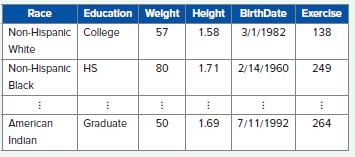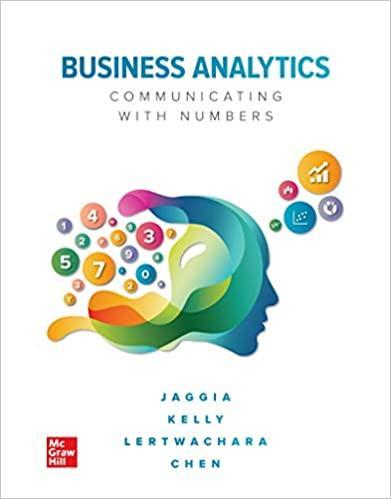Jerry Stevenson is the manager of a medical clinic in Scottsdale, AZ. He wants to analyze patient
Question:
Jerry Stevenson is the manager of a medical clinic in Scottsdale, AZ. He wants to analyze patient data to identify high-risk patients for cardiovascular diseases. From medical literature, he learned that the risk of cardiovascular diseases is influenced by a patient’s age, body mass index (BMI), amount of exercise, race, and education level. Jerry has compiled a data set with the following variables for his clinic’s patients: race (Race), education level (Education), body weight in kilograms (Weight), height in meters (Height), date of birth (BirthDate), and number of minutes of exercise per week (Exercise). The accompanying table shows a portion of the data set.

a. Create a new variable called “BMI” that contains the body mass index of the patients. BMI is calculated as weight in kilograms/(height in meters)2. What is the average BMI of the patients?
b. Create a new variable “Age” that contains the patients’ ages as of January 1, 2019. What is the average age of the patients?
c. Bin the patients’ ages into five equal-size groups. Label the groups using numbers 1 (youngest) to 5 (oldest). How many patients are in group 4?
d. Bin the patients’ total minutes of exercise per week into five equal-size groups. Label the groups using number 1 (highest values) to 5 (lowest values). How many patients are in group 5?
e. Bin the patients’ BMI into five equal-size groups. Label the groups using numbers 1 (lowest values) to 5 (highest values). How many patients are in group 1?
f. Create a risk score for each patient by concatenating the group numbers obtained in parts c, d, and e. How many patients are in the risk group of 555?
Step by Step Answer:

Business Analytics Communicating With Numbers
ISBN: 9781260785005
1st Edition
Authors: Sanjiv Jaggia, Alison Kelly, Kevin Lertwachara, Leida Chen





